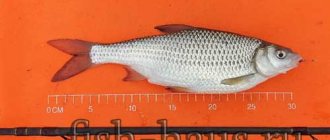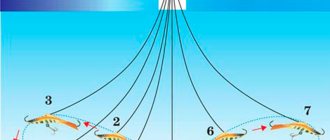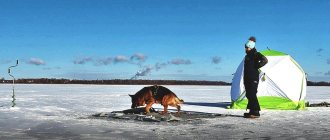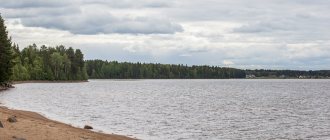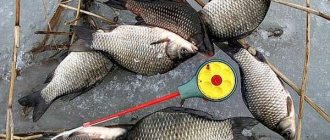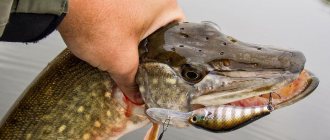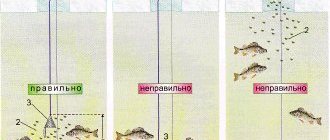Classification
To begin with, let’s just outline the general picture and review the winter fishing rods that are currently used in fishing. Let us immediately clarify that many winter fishing gear can be similar to each other and built on the same types of fishing rods, but, at the same time, differ in equipment, and, as follows from this, in their functional focus.
By fishing directions
Based on the above, we will carry out the initial classification according to fishing directions:
- Jig tackle. These ice fishing rods are used to catch predatory and peaceful fish in still or slow-moving water.
- Float rods, or floats. They are mainly used in lakes and reservoirs for peaceful fish.
- Postavushi. Fishing rods for passive fishing of peaceful and predatory fish in still waters. Unlike floaters, visualization of bites occurs by guards and nods.
- Live bait fishing rods, or live bait. Used for active fishing of various predators.
- Zherlitsy. A type of live bait for passive fishing. Unlike fishing rods, they do not have a fishing rod as such.
- Fishing rods for the current. Specially equipped fishing rods for catching peaceful fish on rivers with medium and strong currents.
- Fishing rods for trolling, or lures. Gear for catching predators with artificial bait.
Often anglers give some of the above gear some versatility. This is usually observed among beginners when an insufficient number of fishing rods for winter fishing have been purchased or manufactured, and they are forced to re-equip the existing ones.
Advice! For the convenience of winter fishing, try to have gear for all occasions.
Types of fishing rods
Before moving on to a description of the equipment of the listed fishing rods, it is necessary to describe the types of fishing rods that are, in principle, used for ice fishing. Winter gear is built on the basis of the following common fishing rods:
- Balalaikas. This is the name given to fishing rods in which the reel and handle are one piece. To wind the fishing line onto the bobbin, you need to unscrew the safety screw and remove the spool. In this case, the fishing line is first threaded into the entrance hole from the outside, then tied to the reel. After installing the spool into the reel, the final winding of the fishing line occurs.
- Fishing rods with handles and legs. These are the most common types of fishing rods for winter fishing. They differ in the design and size of the reels and overall dimensions, which allows them to be used in different types of gear.
- Fishing rod for trolling, or lure. Of course, there is a lot of fishing gear for winter fishing, including those you can use to shine. They can be built on a previous model of fishing rod, but for serious fishing for pike perch or large pike, it is better to have a special tool. Most often this is a form short to 70 centimeters, which is equipped with a large inertial, small inertial or multiplier reel.
Other types of winter fishing rods, although they have external features, can be classified in one of the listed groups in terms of functionality. The exception is girders, which do not have a fishing rod at all, and therefore are not considered in this chapter.
How much will the finished structure cost?
You can make a warm and cozy structure for fishing with your own hands, using the materials that the owner has, and buy the missing ones. Such a house is one of the cheapest options for building a comfortable shelter: the cost of materials can range from 15,000 to 30,000 rubles.
Many fishermen are interested in how much a mobile fishing house costs if you buy it ready-made. Non-collapsible models are sold at prices starting from 120,000 rubles, small folding options are offered for 50,000 - 60,000 rubles.
For example, a high-quality folding house for transportation by car, made of warm blocks, measuring 200x145x145 cm (assembled - 95x150x50 cm), can be bought for 50,000 rubles. The price does not include the stove, furniture, heating and lighting equipment. Improvement of a building can increase its cost by 15,000 - 30,000 rubles.
Based on these data, you can decide which option is preferable - building a winter house with your own hands or buying a ready-made structure. All expenses for comfort and warmth during long-term ice fishing for bream or pike will pay off.
Safety in summer
When fishing, sometimes unpleasant or even dangerous situations occur that can threaten health and life. It's better to think about your safety in advance
I’ll tell you in more detail what experienced fishermen advise to pay special attention to
Unfamiliar bottom topography. When fishing, sometimes you have to go into the water: you need to pull out a large fish or free a hook caught in a snag. There may be a hole at the bottom - it’s easy to trip and lose your balance. Inability to swim and panic can take their toll: people often drown in places where it seems impossible to drown.
Steep shore. Loose or sandy soil combined with the weight of the fisherman himself can cause a landslide, especially if a large fish is hooked and the person exerts effort. It is also dangerous to fish from a clay cliff, especially after rain: it is easy to slip.
Fishing from a boat. It is always worth remembering the weight distribution: if you put all your things at one end and sit there or lean over the edge, the boat may simply capsize. If you are not a good swimmer, wear a life jacket. In any case, he must be in the boat, otherwise he will be fined. A fall can end in tragedy even for a good swimmer. Imagine the scene: a fisherman falls, the boat capsizes and hits him on the head. You'll be lucky if the boat is rubber. A running engine is even more dangerous - it can seriously injure you.
Darkness. The bite is usually best in the early morning - before dawn, but for beginners it is better not to fish at night, especially from a boat: in the dark you can run into a snag and pierce it, and simply get lost. When fishing at night, especially from a boat and on large bodies of water, be sure to use a flashlight: it will be a signal for other fishermen and large vessels, this will help avoid collisions. Signal lights are also required.
Ice fishing tents
Tents for fishing in winter have many differences from summer and off-season ones. First of all, this is the presence of a skirt around the perimeter of the tent, which protects against blowing and snow getting inside.
High-quality winter tents are stable on ice and not susceptible to wind. Considering that condensation forms inside the tent due to heat, it is equipped with air valves.
Recently, for setting up a full-fledged camp on the ice, so-called “mobile baths” have become popular. Essentially this is a two-layer winter tent with a stove. We will talk about them in detail later, but for now let’s dwell a little on light winter tents.
Definitely, a winter tent is needed in the following cases:
- Any night fishing
- In severe frosts with a piercing wind
- Fishing in several days
Which fishing tent to choose?
For some it’s a matter of budget, for others it’s a force of habit, but many fishermen even now, instead of tents, use large plastic bags to shelter from the cold and wind. Sometimes it makes sense to take such a bag with you, even if it is not intended to be used for fishing. It takes up little space and weighs almost nothing.
- Obviously, you should choose a tent depending on how it will be used. When fishing alone during the day, a small, lightest tent will be most convenient, but when fishing at night, for example when catching bream, you will need a larger tent.
- Winter tents are fundamentally different from each other in the design of their frames. The more arcs the frame contains, the more reliable and stable it is.
- The arcs themselves can be metal or fiberglass. Fiberglass arches are heavier than duralumin ones, and cheap fiberglass also breaks.
- On the other hand, in case of weather with strong winds, high-quality fiberglass will bend and unbend under it, and duralumin arches will need to be unbent by hand, after which they may become unusable.
Both non-metallic and metal arcs can be good or bad. Here everything depends on the manufacturer.
Self-cutter
A rod with a self-hook is more a necessity than a luxury in winter. It is very difficult to sit motionless in the cold for a long time, and you often have to get up and warm yourself with tea. And of course, it can be very disappointing when the bite starts right at this moment, and you don’t have time to hook the fish. It was for such cases that a device was invented that automatically responds to the slightest bite, which has become an indispensable assistant for many fishermen (Figure 8).
Figure 8. “Factory” version of a winter fishing rod with a self-hooking hook
Some people believe that using such a device ruins the romance of winter fishing. In such cases, you can simply switch the fishing rod to manual mode and fish in the usual way, waiting for the bite yourself. And use the automatic mode when you have to leave the hole.
There are several types of structures for undercutting, but we will consider the simplest of them.
This option is mounted on a regular piece of plywood, which serves as the base for the entire structure. It’s not difficult to make if you have the right materials and tools.
For production you will need:
- A piece of plywood or a wooden board with a thickness of 20 mm and an area of 30x10 cm;
- Reel, lines, float and hook and weight;
- Spring, or thin wire for its manufacture;
- Thick wire for levers;
- Brackets for attaching the lever.
Draw a design diagram on the board.
At one end we screw brackets to attach the lever. We make a lever from thick wire, bending it according to the diagram. We wind a thin wire or spring onto it. We attach the lever with the spring to the plywood (Figure 9).
We bend the locking bracket from the same thick wire and fasten it in the part opposite to the lever. We attach a piece of elastic to the top of the locking bracket. If desired, it can be strengthened and marked with electrical tape.
Figure 9. One of the stages of manufacturing a self-cutting device
We attach the reel and hanging hook to the wooden base.
Having wound the fishing line, we pass it through the suspension and along the top of the rubber tip of the locking bracket. Next, all that remains is to adjust the tension and spring lever.
With the operating principle of a mousetrap
First, cut a small hole in the back of the plywood. This is necessary to secure the device on ice. A sharpened peg is driven into the hole, and you don’t have to be afraid that a large fish will drag the fishing rod away.
Stepping back a little from the hole, a spring with a long rod, similar to those installed in mousetraps, is attached to the board.
Figure 10. Options for a homemade self-undercutter
At the long end of the spring (on the rod) we attach a clamp cut from a piece of rubber. We wind the end of the fishing line around it.
A wood plate trigger is attached to the front of the plywood. A small hole is drilled in the top of the plate to accommodate the end of the spring rod.
The equipment is attached.
Before installing the trigger and spring, it is important to try them on and adjust them to size. Algorithm for triggering the device:
Algorithm for triggering the device:
- The fish swallows the bait and pulls it;
- The line is tensioned, the latch pushes the trigger and releases the end of the spring;
- The rod straightens and performs a sweep.
Despite the obvious benefits, the hooking device has several disadvantages: even a properly constructed trap is quite bulky, and it is difficult to regulate its force and the sharpness of the hook.
As you can see, making a winter fishing rod is not at all difficult. All the necessary materials are easy to find in the store and workshop. So go for it! May your work please you and bring you only a generous catch!
”
Step-by-step process for making a winter box with photos
How to make a box with your own hands?
We will make it from wood with dimensions of 45x39x23 cm. It will be closed with a lid-box with compartments inside. On top of the lid we will attach a seat made of a special filler, which we will cover with soft leatherette. We will make the walls of the box from seven-layer plywood. We will fill the planks on each side, and on the sides there will be timber measuring 6 cm wide for reinforcement. The result should be a box like this.
Let's pay attention to the locks. They can be purchased in specialized stores
We will fasten the locks with strong screws, as shown in the photo.
The lid opens thanks to the following hinges:
We will fasten these hinges with screws. They will allow the lid to open completely. We will nail oak runners to the bottom of the box.
We will make the runners from timber with dimensions of 20x20 cm. We will fasten them with screws. The runners will allow you to drag the box across the ice. This is very convenient in cases where you have to travel long distances. Another plus about them is that the bottom will not come into contact with snow and ice. Oak slats are very hard and do not absorb practically moisture, hold their shape well and do not rot.
The inside of the box looks like this:
We see that there are metal grooves attached to the sides. We fasten them with thin self-tapping screws. You can insert plywood into these grooves, and thus get partitions. It is very comfortable. We will get three branches. In one you can place fish, boxes of bait and groundbait, and in the second - boxes of bait, a thermos and other accessories. The small one can accommodate fishing rods. This is the internal configuration of a hand-made box:
We will make a hole on one of the sides through which we will throw the fish.
We will use a belt like this:
You can use a belt from an old bag that has already become unusable. We will attach it to the box using this loop:
We tighten this element with three screws or self-tapping screws.
We attach 10 mm thick polyethylene foam insulation to the lid using waterproof glue. It does not allow moisture to pass through and is quite soft.
We cover the top of the insulation with dermantin:
We will make the dermantine coating in this way:
This cover can be stapled to the sides of the box using a nail gun. The result is a reliable design.
We coat the resulting fishing box with our own hands with waterproof varnish in two layers. You can use parquet varnish. We make sure that all elements and sidewalls are carefully coated.
When opened, the box looks like this:
We will make the lid in the form of a box 6 cm high. Additional compartments can be made inside it. To do this, we will also make grooves into which the plywood is inserted. We fasten the plywood on top so that we get sashes. We attach special clamps on the sides, and screw the handles on top with self-tapping screws. The result will be approximately the same design as in the bedside tables. To open the sash, you need to pull the handle. In these compartments you can store elements of fishing equipment.
As you can see, we have a completely functional and spacious box. Now we know how to make a fishing box for winter fishing with our own hands.
Manufacturing Features
We should start with the fact that for any fishing it is important to choose the right type of fishing rod. And for winter, this will almost be the key to success.
To start making homemade fishing models, you need to decide what kind of fish the rod is intended for. We should not forget that for such a device the following will be important:
- good functionality;
- convenience;
- small mass.
The design of a winter fishing rod should be such that it does not misfire during the fishing process. For example, for this reason you should not make a plastic whip, because it can easily burst. In general, all models of such devices consist of the following basic elements:
- handles;
- reels or reels;
- whip or fishing rod.
If a model is being made for fishing with a jig, then there must still be a nod there. Its presence is not necessary for trolling, but it can be used if a light bait was chosen and the bite is not too active. The winter fishing rod itself is a short fishing rod, the length of which does not exceed 30 centimeters, equipped with a reel with fishing line or a small inertial reel.
It must have legs for mounting on ice and a handle made of materials that will make it possible to isolate the cold elements of the device. It is best when the handles are made of foam or cork.
It should be remembered that winter gear is usually used in severe frost, often with mittens or gloves. Therefore, the device must be simple and reliable, because setting it up, much less repairing it in the cold, is not the easiest or most convenient thing. So the selection of materials will be extremely important for the successful use of such a device in winter.
But the reason for independently creating such a device can be called:
- desire to save money;
- the opportunity to make something yourself;
- There was no model suitable for the fisherman in the store.
Transportation and storage
Homemade houses are varied - when making them, each fisherman is guided by his own capabilities and knows how he will store and transport his “brainchild”. There are different options:
- a small collapsible structure is transported in the trunk and stored in the garage;
- a comfortable house on wheels can be moved using a towed vehicle;
- ski booths are transported by snowmobiles.
Non-demountable structures are stored under a canopy.
To learn how to make a house for winter fishing with your own hands, watch the following video.
Network installation methods
Network installation methods
Installing networks in winter, under ice, is a very labor-intensive task. A mine is cut in the ice with an ice pick, and holes are drilled from it in a line at a distance of 2–3 m from one another. Then a pole with a rope tied to its end is lowered into the lane (the length of the pole is 0.5–0.8 m greater than the distance between the holes) and pulled with a hook from one hole to another. Then the rope stretched under the ice is tied to the top rope, and the net is pulled under the ice. In shallow water, in no case should the floating cord be allowed to touch the lower edge of the ice or be close to it - in severe frost, the ice thickness increases up to 10 cm per day, and you can lose frozen gear, or pick it up only in the spring, filled with spoiled fish.
But sometimes you still have to fish at shallow depths, especially in the first ice, before the fish slide into deep wintering holes. In this case, it is useful to measure the depth of the reservoir (not only at the ends of the established order of networks, but at several points along its length, so as not to accidentally land on an underwater hump). Then, if the fishing is not supposed to be one-day fishing, you need to calculate the approximate increase in ice using the data in the table. 4. The numbers indicated there are quite approximate: for example, muddy or brackish water freezes worse than clean and fresh water, and, accordingly, the increase in ice thickness occurs more slowly; Other factors also have a great influence: the depth of the reservoir, the strength of the current, the thickness of the snow cover, etc. We can assume that the table shows the maximum values - under conditions most favorable for water freezing.
Table 4. Estimated increase in ice thickness
If, as a result of calculations, it turns out that the nets will fall into the “risk zone” after some time, the fishing period should be limited. However, predicting air temperature is quite difficult even for meteorologists...
There is an old way to protect networks from freezing. Here's what: along the entire length of the net (or in that section of it that falls on the elevation of the bottom), small additional floats are not very often tied to the upper selection of the net on streamers made of thin thread 25–30 cm long. When, when sampling the net, it turns out that these The floats are frozen into the ice and the lines are torn, so the fishing location needs to be changed.
On rivers, sometimes they do not drill a chain of holes, but use the force of the current to stretch a rope under the ice, tying a buoy to it (a large piece of foam plastic, an empty plastic bottle, etc.). This method is especially convenient in first-ice conditions, in places with thin and fairly transparent ice, through which the buoy is clearly visible. However, closer to the middle of winter, most fish avoid the current, accumulating in quiet-water holes.
For safety reasons, after finishing fishing, it is necessary to fence off the lanes with clearly visible poles - they are cut in a fairly large size, and, sprinkled with snow, can provide another fisherman or a person who accidentally goes out on the ice with an unplanned water procedure.
The development of science and technology has not bypassed the very labor-intensive process of installing networks under the ice. But, alas, progress in this matter occurred anywhere, but not in our country. Only in recent years have all sorts of more or less ingenious devices begun to appear in Russia, designed to make the work of lovers of winter net fishing easier.
Among them there are also very intricate ones. For example, something like a miniature electric submarine - tied on a long cord, such a “submarine” floats in wide circles around a hole (at the very bottom surface of the ice) until the cord catches on a wire hook lowered into another hole. After that, stretching the net between the holes is not difficult.
It is much easier to use the “cuttlefish” winch described above in the section on sweeps.
The Chinese-made winch, nicknamed the “torpedo,” has a similar operating principle to the “cuttlefish.” It really looks like a half-meter-long metal torpedo with two gears on its sides. The “torpedo” operates electrically, using batteries, and, according to the manufacturer, their capacity is enough to stretch the cord under the ice over a distance of 1.5 kilometers.
The second advantage of the “torpedo” is that it does not require cutting out a large lane; the device can be lowered into a regular hole. True, a net with a large catch cannot be pulled through it, but for catching with nets you can do without a saw. The third plus is the price; a “torpedo” costs less than a branded Finnish winch.
However, as already mentioned, the more complex the equipment, the more likely it is to break down. Especially when it comes to Chinese-made equipment.
This text is an introductory fragment.
DIY single tent
DIY single tent (pattern)
In order to sew a tent, you need to choose lightweight material. I used a thin tarpaulin (whatever I had on hand), but I think a thick cotton fabric would work just fine.
The proposed design has a roof ridge that is not horizontal, like commercially produced samples, but inclined. This is due to the fact that when installing such a tent with its back side facing the wind, its windage will be minimal, and air flows will flow around it.
- When making this type of tent, up to 30% of material is saved, and accordingly, the weight is reduced.
- Such a tent uses only one riser - at the entrance, and the need for a second riser disappears by itself. Instead, a nylon guy is used (from point “a”).
- But the need for a riser may also disappear if there is a tree nearby. In this case, the front guy (from point “fg”) is tied to the tree at the desired height.
- Such a tent can be installed easily and in a short time by one person, which is its big advantage, especially in bad weather.
- As for the riser at the entrance, if it causes some inconvenience, you can use two stands, which are located under the canopy at the entrance in the form of the letter “L”. By arranging the entrance to the tent in this way, you will never get into trouble due to forgetfulness or haste. Such a device for entering the tent will not prevent you from bringing a backpack or spruce branches inside for bedding.
- There is no point in describing the technique of making a tent in detail: everything is very clearly visible from the pattern. I will briefly dwell on just a few points.
- The main guy wire is sewn between points “a – fg” (one continuous nylon cord), additional guys are sewn to points “b” and “c”. Loops for pegs are sewn into the corners of the floor from the outside.
- The loops are all made from the same nylon rope. The doors at the entrance at points “fh - gi” can be equipped with a zipper type fastener.
When the tent is ready, it needs to be given water-repellent properties. This can be done using one of the methods described below.
- The first recipe. Take 4 liters of warm water, dissolve 500 grams of laundry soap in it, add 25 grams of washing soda and 450 grams of rosin powder. Place the tent in the resulting solution and let it lie there for about 15 minutes. Then remove the tent, wring it out and dry it.
- The second recipe. Soak the tent with a 40% warm solution of laundry soap. Then take it out, squeeze it out and put it in a 20% solution of copper sulfate.
After soaking for 15-30 minutes in vitriol, dry the tent. In addition to water-repellent properties, the tent will also acquire a nice green color.
There are other ways to make a tent water-repellent, but they are a little more complicated. Anyone who doesn’t want to bother with such “chemistry” can simply cover the shelter with plastic film, securing it with ordinary clothespins.
The difference between fishing on a river and a lake
Fishing on a river in winter is different from fishing in still water. There are more bites from large fish in the current. If you fish at great depths, then the length of the fishing line will be greater than the depth of the river - an adjustment for the current. Also, the line will be positioned level with the bait, and not above it, so the game with the bait will be completely different. Beginner fishermen should take this into account. During the current, the bait must be placed under the fish’s nose and encouraged to bite.
There are fish that test a fisherman's strength. So, for example, fishing for burbot in winter occurs during the most transitional period. Strong wind, snow and rain, in this weather, the burbot becomes more active. It’s not for nothing that they call it the freshwater devil.
The peculiarities of national fishing in winter are the constant overcoming of difficulties, extreme weather conditions, everything that characterizes real men. And these are fishing jokes, without which it would be impossible to understand the Russian character. Watch the video:
https://youtube.com/watch?v=hw1p_A9CsU0
Some anglers spend a lot of time in the cold, sometimes every day. To protect them from the cold and wind, they make small temporary buildings. A fisherman's house is the best solution for a comfortable stay on a long winter fishing trip.
Advantages and disadvantages
In Europe and the USA, people accustomed to comfort often resort to the help of such structures. In Russia, homemade houses also began to appear. On the ice of the lake located next to the village, you can see small structures placed on skis or simply dragged by a snowmobile.
It is more difficult to organize a cozy fishing trip for city residents. The house, although small, has nowhere to store it and nothing to deliver it with. Still, there is a way out for city dwellers: you need to build a collapsible structure, the parts of which will fit in the trunk of a car, and upon arrival at the place, assemble them into a life-saving house that will protect from the chilly wind, and if you install a stove-stove, it will warm you up in the cold.
What are the advantages of a house for winter fishing, and is it really necessary? Let’s try to understand this issue. Let's start with the positive points:
- the house will save the fisherman from hypothermia and keep him healthy;
- there is no need to leave it while fishing, the holes are organized directly in the floor;
- if you install a stove-stove, you can warm up, boil a kettle, drink tea and warm up freezing holes with boiling water;
- you can stay overnight in a house equipped with a stove and a sunbed;
- the structure, mounted on skis or wheels, moves easily on ice;
- thanks to the house, the fisherman will stay fishing much longer than he could withstand in the open space;
- even a sharp deterioration in the weather will not cause an escape from the reservoir.
Now let's talk about the disadvantages. There are not many of them, but they are significant.
- To purchase a house, you will have to invest in the purchase or material for its manufacture.
- Even when disassembled, there are difficulties in storage and transportation. The design details will displace the rest of the equipment.
- The house has a certain weight, especially if it is designed for 2-3 people, which means that not every ice can support it.
The thickness of the ice must be taken into account; it must have the following parameters:
- 10 cm – for a load of 100 kg while on a fresh body of water;
- 15 cm – for a load of 100 kg while in salt water;
- 30-40 cm - for staying with a car and a house with a total load of 6 tons.
House for winter fishing
Winter fishing is an extreme activity: frost, high humidity, piercing wind blowing across the expanses of the reservoir, frozen fishing line, which you have to untangle only with your bare hands. Not everyone can withstand such tests.
- But there are other conditions: a cozy, warm house located directly above the hole, a kettle warming up on the stove, and even beds.
- Accustomed to steadfastly enduring all hardships and hardships, fishermen of the old school can snort contemptuously: they say, these are not our methods, what pleasure is there in such fishing? But there are also quite a few adherents of comfort. A tent can be called a transitional step to “warm” fishing, but it has a number of significant disadvantages.
- In strong winds it has to be further strengthened; when it thaws, water sloshes under your feet. And, most importantly, the tent cannot be quickly moved to a hole located some ten meters away. A winter fishing house is free of these shortcomings.
Overview of the winter house
The invention of mobile houses is claimed by the Americans, but such devices have long been in use among residents of our villages located in close proximity to water bodies.
Homemade structures come in a wide variety: from lightweight plywood houses on skids, designed to be moved by hand, to massive, well-equipped structures in which you can spend several days on the pond.
But what about residents of megacities who simply have nowhere to keep such a house? And it is not designed for long journeys. There is a solution: you can make a folding house for winter fishing with your own hands.
Handicraftsmen make various versions of houses, both for themselves and to order. This is what one of them looks like.
- The base is a plywood sheet of the FK or SFK brand, 6 mm thick and 180x130 cm in size (of course, the dimensions may be different). This is the floor of the future “cottage”. Ski racks are attached to the bottom, providing a clearance of 25 cm, and the skis themselves are attached to them. All connections are hinged, which allows you to quickly disassemble and assemble the structure.
- In addition, the racks provide the ability to install the house above the hole in a raised or lowered position. The choice of position depends on weather conditions. Access to the holes is provided through hatches in the floor. The frame for the walls, roof and door is made of wooden blocks, treated with an antiseptic and painted to protect against moisture.
- All connections are also made on hinges. Spacers are installed along the perimeter of the roof and the ridge. Then the whole thing is covered with thick fabric, and the end walls are covered with transparent polycarbonate for lighting. The mobile house for winter fishing is ready. All that remains is to equip it inside. The collapsible table, bench and chairs are made of plywood.
- When folded, they are small in size and easy to transport.
Potbelly stove in the house
A small stove-stove, powered by wood or diesel fuel, will complement the “interior”. Hot water is useful for more than just making tea. It is convenient for her to melt ice in freezing holes. The house can accommodate up to 3 people at the same time, and one of them is provided with a sleeping place.
Transportation and storage of the house
For transportation, the “building” is folded into a “pancake” measuring 180x130x15 cm. To do this, you just need to remove the spacers. The weight of the house is about 20 kg, and even alone it is not difficult to load it onto the roof of a car.
- If the structure needs to be dragged over a considerable distance across a body of water, it does not have to be loaded onto a car, but you can use skis. When folded, the house can be easily stored in a garage or shed.
- However, if there is neither one nor the other, and the square footage of the apartment is small, then even such a small item can cause some inconvenience.
- You can get out of this situation by making a house of a similar design, but not with a solid floor, but with a folding floor made from several pieces of plywood connected with hinges. When folded, it is a box that can easily fit in the trunk of a car.
- In working condition, the house is similar to the first option, but disassembly takes a little more time: 15 - 20 minutes. You can come up with quite a lot of options for a collapsible bottom and, in the end, achieve the desired size.
- A folding house for winter fishing can be made using other technologies. The video shows the assembly of a house consisting of 6 foam panels: a floor, four walls and a roof.
The design is extremely simple, but it can also protect the fisherman from the cold.
How to make a folding fisherman's house
When making a house for comfortable fishing, construction can take a long time, but the warm summer season is enough for the most leisurely craftsmen. The main criterion is the quality of the design, its comfort, speed of assembly and disassembly, as well as ease of transportation.
Blueprints
Designing a future structure is an important moment in preparing the construction of a structure. All parts must be drawn on paper - the drawings must indicate fastening methods, details of the movable base and frame.
It is important to calculate the dimensions of the structure, taking into account the transportation methods (trailer, car roof). Knowing the dimensions of the future structure, you can calculate the amount of materials required. Drawings of folding furniture will also help to make high-quality interior arrangements of the house.
Sometimes winter fishing houses are used in inclement weather in spring, summer and autumn, installing them on boats and catamarans. To do this, you need to consider the option of using a house without a floor - the assembled structure must be stable. The design of the shelter provides for ways to attach it to a summer flotation device.
Materials
Light materials are used for the fisherman's house. The frame under the floor (for the runners or wheels) is made of aluminum or other durable materials. The flooring must be rigid - made of plywood (grade SFK or FK, 6 mm thick), boards. The frame of the shelter is made of wooden beams, aluminum or duralumin profiles.
The outside walls are sheathed with fabric, tarpaulin or any light panels (sandwich panels), even polystyrene foam is used. Inside the walls you can additionally line them with old carpets, blankets, felt or insulation.
You can decorate the walls inside the house with plywood, and apply a 5 cm layer of polyurethane foam to the external surfaces. Two opposite walls are made transparent for internal lighting. For this, polycarbonate is used.
The hinged connections of the parts of the house (fasteners and canopies) are selected depending on the design features of the structure. Beds, seats, boxes for things, equipment and provisions are made from wooden boards.
Manufacturing process
The floor of the folding house is made of plywood sheets, and the size of the floor will be approximately equal to the size of the sheet. For ease of transportation, the floor can be made collapsible, consisting of several blocks. The floor is attached to a frame with racks (clearance - 25 cm), skis or sleds are attached to the racks for transportation.
Skis can be made of aluminum or wood. Eyelets are attached to the base so that the structure can be towed. Thanks to ski racks, the structure can be lowered or raised depending on need and weather.
Hatches in the floor provide access to holes that can be drilled after installing the shelter. Near the holes for the holes, fastenings for tackle are provided. Hole holes should be closed with doors to avoid heat loss after fishing.
For the frame of the house (walls, doors, roofs) a wooden beam is used, which is pre-treated with antiseptic agents and painted. The frame connections are of the hinge type, which allows you to assemble and disassemble the house (parts of the structure can be connected using door hinges). To strengthen the perimeter of the future structure, spacers made of wooden beams or metal profiles are provided.
All surfaces, except the end walls, are covered with dense but light material (for example, fabric, felt or tarpaulin). The end planes are finished with transparent materials (usually polycarbonate) for lighting inside the house.
A small entrance door is made on one of the walls, it is insulated so that there are no gaps in the structure. For ventilation inside the building, a piece of PVC pipe is inserted into a hole in the roof. The ventilation pipe must have a plug.
Rating of winter tents up to 5000 rubles
Such tents do not have a high-quality frame or material. The degree of moisture resistance of the awning is no more than 2000 mm. The design will not be able to save a fisherman in open areas from strong gusts of wind and precipitation. When choosing, it is also worth considering that the tents are not equipped with additional equipment.
Here is the list, broken down by properties:
- company name;
- photo;
- characteristics;
- advantages;
- flaws.
Go!
Condor WDT1515K5
Automatic model. The design unfolds quickly and easily. Frame made of metal plates. The awning is nylon adapted to low temperatures. Silicone impregnation is also present. High-quality and budget option. Requires high-quality drying after fishing.
- quickly folds and dismantles;
- The kit includes a backpack for the tent;
- high-quality frame;
- Doesn't take up much space when folded, lightweight.
- The set does not include screws for fastenings.
I like1
Helios Delta yellow
The tent is comfortable and lightweight. The shape is gable. Capacity – 2 people. The frame is fiberglass. The corners are reinforced with special pockets made of webbing and fabric inserts. Awning – polyester. There are loops for securing guy ropes. There is ventilation.
- high-quality frame and connections;
- ventilation that prevents precipitation;
- wide skirt with stretch eyelets;
- there are screws, guy wires;
- light weight and size.
- screwdrivers are not of high quality.
I like
Double tent. It provides good protection from strong winds and frost. The awning is a three-layer fabric, windproof nylon. The frame is umbrella type, quickly disassembled, semi-automatic. The frame consists of durable aluminum-duralumin rods. There is a ventilation valve. There is a snow skirt made of waterproof fabric.
- design resistant to strong gusts of wind;
- durable and high-quality frame;
- ventilation;
- quick installation and dismantling;
- light weight;
- The kit includes a case.
- there is no internal bottom;
- The locks at the entrance are not of good quality.
I like
The capacity of the tent is two people. The frame is made of stable fiberglass arches. The awning is wind-resistant, made of polyester. The tent is quickly assembled and dismantled.
- there is a snow skirt;
- ventilation window;
- light weight;
- compactness;
- quick installation and dismantling;
- resistance to strong gusts of wind.
- no artificial bottom;
- minimal protection from moisture.
I like
Choosing a box for fishing in winter
Felt boots
Most often, your feet freeze the fastest on ice. If your shoes are tight or not warm enough, your feet will freeze quickly.
After all, during winter fishing you will have to sit a lot near the hole and wait for a miracle. A great find for warming your feet in cold weather are good old felt boots.
They are fairly lightweight, warm, and also absorb moisture well, but there is one significant drawback. When felt boots get wet, they absorb all the moisture, which makes them heavy, and your feet quickly freeze in damp felt boots.
This problem can be fixed. You can buy so-called fishing shoe covers, which can be worn either over felt boots or other winter fishing shoes; by the way, the reviews about shoe covers are mostly positive.
They are not expensive, last for a couple of seasons, and most importantly, the shoe covers have a high top, which will not allow the felt boots to get wet.
Selection of gear for winter roach fishing
Since large specimens are not caught so often, you can purchase the simplest fishing rod for fishing with a jig or with a float. If the hook mainly catches small roach (no more than 200 g), any fishing rod with a reel and reel is suitable for fishing. However, if you decide to get serious about winter fishing, it is better to get high-quality branded gear. Since they are more durable, it will be possible to catch heavier fish without damaging it.
For catching roach with float tackle or jigs, a fishing line with a diameter of 0.08-12 mm is suitable, which will support fish weighing 150-200 grams. However, when the depth of the reservoir is large enough, the fish behaves very actively, and not only small fish are caught, but also larger fish (300-500 g), it is better to change the fishing line to a thicker one. In this case, take a vein with a diameter of 0.14-0.16 or even 0.18 mm. The fishing rod must be equipped with a long nod (4-7 cm or more)
This is very important, as it ensures a smooth motion of the jig in the water, which the roach really likes, and it readily bites on it.
Don't forget about the float. If you intend to fish for roach in still water or areas with weak currents, it can be quite light (about 0.5 grams). If the current is more intense, take a heavier float. Tie the float to the fishing line, attach a few shot balls just below, step back about 10 cm and attach a small hook to the end of the fishing line. The gear for ice fishing for roach is ready.
How to set up a house for fishing
Inside the house there is a sunbed, table, chairs and drawers for storing things. Furniture is made from boards or thick plywood. For ease of transportation, folding options are often used. During the day, the loungers can be folded or raised by attaching them to the wall.
The room is lit with battery-powered lamps (LED flashlights). It is advisable to install overhead lighting and below near the holes. Ventilation can be done in the form of a small window. Heat in the building is provided by various heaters. These can be infrared gas stoves, kerosene fireplaces or small potbelly stoves running on diesel fuel or wood.
If the heating method does not provide for the function of cooking food and boiling water, then you need to use a separate stove for these purposes - fishermen will need not only hot tea, but also hot water for defrosting the holes.
Lake village Casino
I also mentioned this reservoir in the last post. There was a request to describe it in more detail. I spoke in that note about the peculiarities of this lake. So, its peculiarity is that it is a karst fault filled with water. I don’t know how true this is, but in the 80s of the 20th century, according to the stories of my friends, an incident occurred. The direct road from the village passed by this lake. Sanninskoye in the village. Staro-Ilikovo. The ravines near the lake became shallow in winter, and one tractor driver, returning home from Sanninskoye, decided to drive directly on the ice of the lake. The ice could not stand it, and the tractor went under the water along with the tractor driver. No matter how many times they tried to find this tractor and get it, to no avail! So the greatest depth is not measured. From the shore the depth increases gradually.
Another interesting observation of mine. One day my neighbor and I learned about a lake not far from the village of Novo-Ilikovo. We decided to scout him out. We found it, by the way, it is not on the maps. The lake is small, 50-70 meters wide. It also looks like it is of karst origin. There was crucian carp there and it was quite good. My neighbor and I came there several times and never returned without a catch. Locals said that this lake underground is connected to Lake Casino. The direct distance between them is two kilometers. I don't know how true this is. But one day my neighbor and I decided to go fishing on this lake again, and when we arrived, there was no water in it. In the center of the funnel we saw this:
The water is gone. Where? There was nothing to do, we decided to go directly to Lake Kazinskoye. When we arrived, we noticed that the water level in the lake was higher than usual. Although there was no rain for two weeks. So don't believe the rumors now.
Only crucian carp is found in Lake Kazinsky. Medium, palm size. Just right for hot weather. I don’t mistake verkhovka for fish. It only interferes with fishing. We did not find any other species of fish in the lake.
One shore of the lake (eastern) is wooded, there are few approaches from the shore.
But the opposite shore is very picturesque, with a beautiful peninsula covered with birch trees. There are many places and approaches here. You can get there from the pond in the village of Bishtinovo. From the road, Bishtinovsky Pond will remain on the right.
It's about three kilometers away. I warn you right away, so as not to take risks, it is better to drive an SUV. You can also drive a puzoterka, but if it rains, getting out will be problematic.
Happy fishing everyone! NHNCH everyone!
